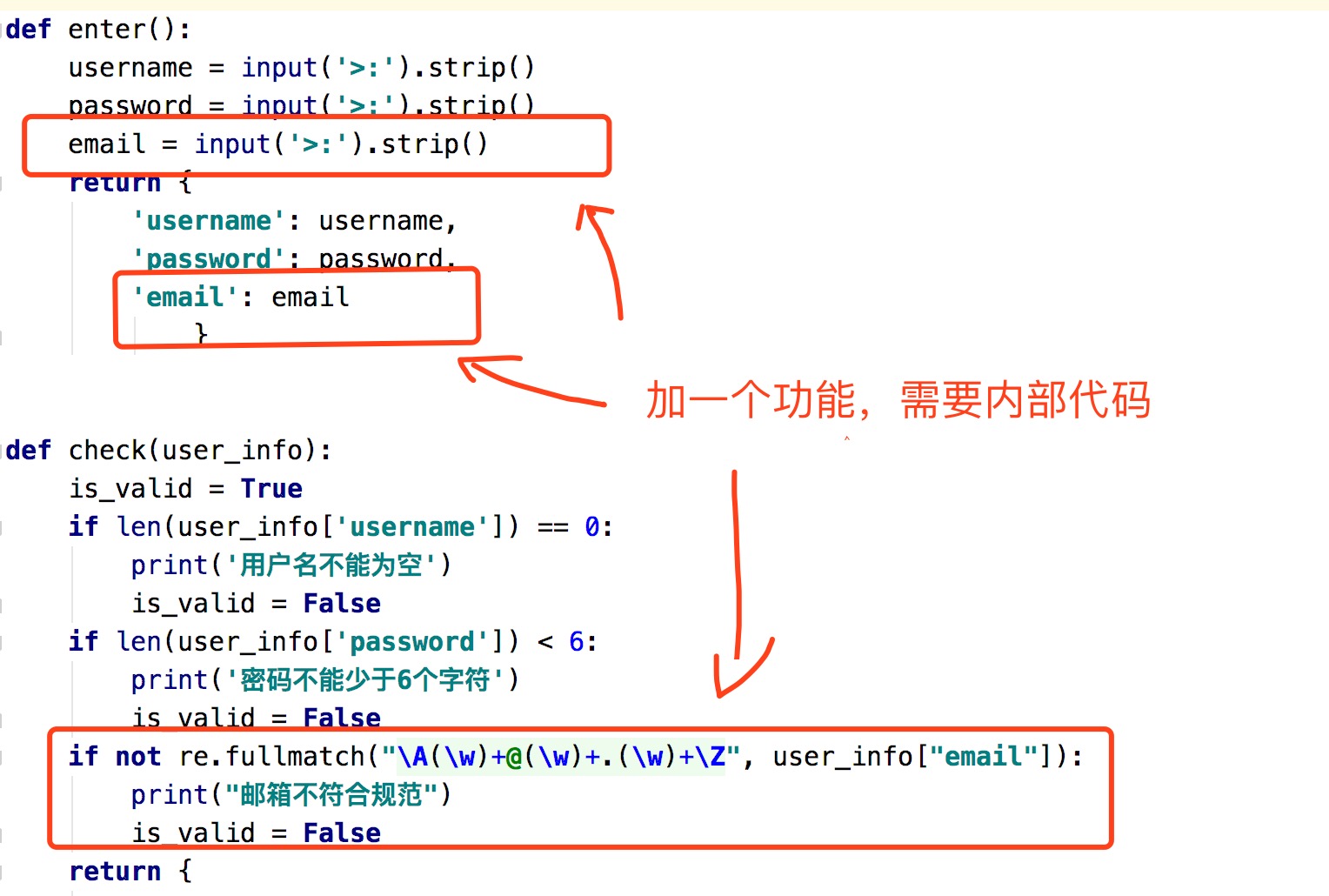1 - 面向对象基础
1、编程范式
- 编程是 程序 员 用特定的语法+数据结构+算法 组成的代码来告诉计算机如何执行任务的过程 。
- 两种最重要的编程范式分别是
- 面向过程编程
- 面向对象编程
2、面向过程编程(Procedural Programming)
- 面向过程:核心是过程二字,过程是解决问题的步骤,设计一条流水线,机械式的思维方式
-
- 优点 :复杂的问题流程化,进而简单化
- 缺点 :可扩展性差
代码示例:
"""实现一个用户注册功能""" # 1.用户输入 # 2.验证是否符合标准 # 3.注册 def enter(): username = input('>:').strip() password = input('>:').strip() return { 'username': username, 'password': password } def check(user_info): is_valid = True if len(user_info['username']) == 0: print('用户名不能为空') is_valid = False if len(user_info['password']) < 6: print('密码不能少于6个字符') is_valid = False return { 'is_valid': is_valid, 'user_info': user_info } def register(check_info): if check_info['is_valid']: import json with open('users.txt', 'w', encoding='utf-8') as f: json.dump(check_info['user_info'], f) print('注册成功') def main(): user_info = enter() check_info = check(user_info) register(check_info) if __name__ == '__main__': main()
如果添加一个新功能: 邮箱验证(需要动函数内部代码,这不符合开放封闭原则,因而面向过程编程可扩展性差)

3、面向对象编程
- 面向对象编程:核心是 对象 ,对象是特征与技能的结合体
- 优点:可扩展性高
- 缺点:编程复杂度高
- 应用场景:用户需求经常变换,互联网应用,游戏,企业内部应用。。。
4、定义类与实例化出对象
""" 类就是一系列对象相似的特征与技能的结合体 强调:站在不同的角度,得到的分类是不一样的 在现实世界中:一定先有对象,后有类 在程序中,一定先定义类,后强调类来产生对象 站在luffycity的角度,大家都是学生 在现实世界中: 对象1:张三 特征: 学校='luffycity' 名字='张三' 性别='女' 年龄=18 技能: 学习 吃饭 睡觉 对象2:李四 特征: 学校='luffycity' 名字='李四' 性别='男' 年龄=28 技能: 学习 吃饭 睡觉 对象3:王五 特征: 学校='luffycity' 名字='王五' 性别='女' 年龄=38 技能: 学习 吃饭 睡觉 总结现实中路飞city的学生类 相似的特征: 学校=’luffycity‘ 相似的技能 学习 吃饭 睡觉 """
代码实现如下:
# 先定义类 class LuffyStudent: school = 'Luffycity' # 共有属性 def learning(self): print('is learning') def eating(self): print('is eating') def sleep(self): print('is sleeping') # 后产生对象 stu1 = LuffyStudent() stu2 = LuffyStudent() stu3 = LuffyStudent() print(stu1) print(stu2) print(stu3)

5、如何使用类
(1) 查看类的命名空间
# 查看类的命名空间 print(LuffyStudent.__dict__) print(LuffyStudent.__dict__['school']) print(LuffyStudent.__dict__['eating'])
(2)查看类的属性
# 查 类的属性 print(LuffyStudent.school) # LuffyStudent.__dict__['school'] print(LuffyStudent.eating) # LuffyStudent.__dict__['eating'] # 运行结果 Luffycity <function LuffyStudent.eating at 0x01F71738>
(3)增加类属性
# 增加 LuffyStudent.addr = '南京' print(LuffyStudent.__dict__) print(LuffyStudent.addr) # 运行结果 {'eating': <function LuffyStudent.eating at 0x005A17C8>, 'addr': 'xian', '__dict__': <attribute '__dict__' of 'LuffyStudent' objects>, 'learning': <function LuffyStudent.learning at 0x005A1738>, '__weakref__': <attribute '__weakref__' of 'LuffyStudent' objects>, 'sleep': <function LuffyStudent.sleep at 0x005A1810>, '__doc__': None, '__module__': '__main__', 'school': 'Luffycity'} 南京
(4)删除类属性
# 删除 del LuffyStudent.addr print(LuffyStudent.__dict__) #>>> {'eating': <function LuffyStudent.eating at 0x005A17C8>, '__dict__': <attribute '__dict__' of 'LuffyStudent' objects>, 'learning': <function LuffyStudent.learning at 0x005A1738>, '__weakref__': <attribute '__weakref__' of 'LuffyStudent' objects>, 'sleep': <function LuffyStudent.sleep at 0x005A1810>, '__doc__': None, '__module__': '__main__', 'school': 'Luffycity'}
(5)修改类属性
# 修改 LuffyStudent.school = 'OldBoy' print(LuffyStudent.school) #>>> OldBoy
6、如何使用对象?
- __init__ 方法用来为对象定制对象自己独有的属性
- 如为德玛 定制自己独有属性(HP、MP)
# 1.先定义类 class LuffyStudent: school = 'Luffycity' def __init__(self, name, gender, age): self.name = name self.gender = gender self.age = age def eating(self): print('is eating') def learning(self): print('is learning') # 2.后产生对象 stu1 = LuffyStudent('张三', '女', 18)
7、属性查找
# 先产生类 class LuffyStudent: school = 'Luffy' def __init__(self, name, gender, age): self.name = name self.gender = gender self.age = age def learning(self): print('is learning') def eating(self): print('is eating') def sleeping(self): print('is sleeping') # 后产生对象 stu1 = LuffyStudent('张三', '女', 18) stu2 = LuffyStudent('李四', '男', 28) stu3 = LuffyStudent('王五', '女', 38)
print(stu1.__dict__) print(stu2.__dict__) print(stu3.__dict__) # >>> {'name': '张三', 'gender': '女', 'age': 18} {'name': '李四', 'gender': '男', 'age': 28} {'name': '王五', 'gender': '女', 'age': 38}
(1)类的特征属性
# 类中的数据属性:是所有对象共有的 print(LuffyStudent.school, id(LuffyStudent.school)) print(stu1.school, id(stu1.school)) print(stu2.school, id(stu2.school)) print(stu3.school, id(stu3.school)) #>>> Luffy 43075776 Luffy 43075776 Luffy 43075776 Luffy 43075776
(2)类的技能函数
# 类中的技能函数:是绑定给对象,绑定到不同的对象是不同的绑定方法 print(LuffyStudent.learning) print(stu1.learning) print(stu2.learning) print(stu3.learning) #>>> <function LuffyStudent.learning at 0x02951780> <bound method LuffyStudent.learning of <__main__.LuffyStudent object at 0x0294FA90>> <bound method LuffyStudent.learning of <__main__.LuffyStudent object at 0x0294FAF0>> <bound method LuffyStudent.learning of <__main__.LuffyStudent object at 0x029621F0>>
(3)调用类的技能函数
- 类调用
LuffyStudent.learning(stu1) LuffyStudent.learning(stu2) LuffyStudent.learning(stu3) # 》》》 张三 is learning 李四 is learning 王五 is learning
- 对象调用
stu1.learning() # LuffyStudent.learning(stu1) stu2.learning() stu3.learning() #》》》 张三 is learning 李四 is learning 王五 is learning
(4)全局变量,局部调用
# 定义一个属性 style = ’from luffy class‘ LuffyStudent.style = 'from luffy class' print(stu1.__dict__) print(stu1.style) # 调用
8、一切皆对象
- 补充说明
- 站的角度不同,定义出的类是截然不同的;
- 现实中的类不完全等于程序中的类,比如现实中的公司类,在程序中有时需要拆分成部门类,业务类等等;
- 有时为了编程需求,程序中也可能会定义现实中不存在的类,比如策略类,现实中并不存在,但在程序中却是一个很常出现的类
我是Edison_chen
一个在自学道路上摸爬滚打的人!



 浙公网安备 33010602011771号
浙公网安备 33010602011771号